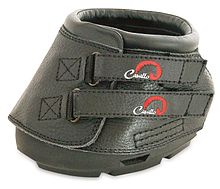
A horseshoe is a fabricated product designed to protect a horse hoof from wear. Shoes are attached on the palmar surface of the hooves, usually nailed through the insensitive hoof wall that is anatomically akin to the human toenail, although much larger and thicker. However, there are also cases where shoes are glued.
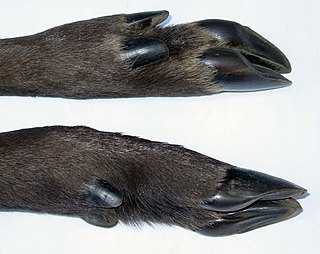
The hoof is the tip of a toe of an ungulate mammal, which is covered and strengthened with a thick and horny keratin covering. Artiodactyls are even-toed ungulates, species whose feet have an even number of digits; yet the ruminants with two digits are the most numerous, e.g. giraffe, deer, bison, cattle, goat, and sheep. The feet of perissodactyl mammals have an odd number of toes, e.g. the horse, the rhinoceros, and the tapir. Hooves are limb structures restricted to placental mammals, which have long pregnancies; however, the marsupial Chaeropus had hooves.

A riding boot is a boot made to be used for horse riding. The classic boot comes high enough up the leg to prevent the leathers of the saddle from pinching the leg of the rider, has a sturdy toe to protect the rider's foot when on the ground and has a distinct heel to prevent the foot from sliding through the stirrup. The sole is smooth or lightly textured to avoid being caught on the tread of the stirrup in the event of a fall.
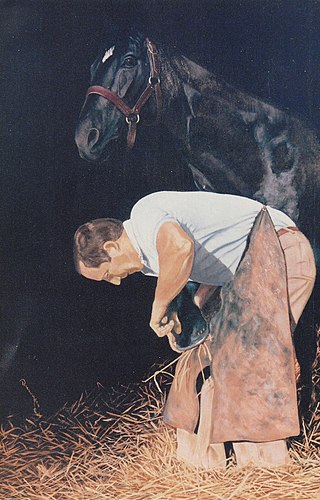
A farrier is a specialist in equine hoof care, including the trimming and balancing of horses' hooves and the placing of shoes on their hooves, if necessary. A farrier combines some blacksmith's skills with some veterinarian's skills to care for horses' feet. Traditionally an occupation for men, in a number of countries women have now become farriers.

Motorcycle boots are associated with motorcycle riders and range from above ankle to below knee boots. They have an outside of a typical boot but a low heel to control the motorcycle. To improve motorcycle safety, motorcycle boots are generally made from a thick, heavy leather and may include energy absorbing and load spreading padding, metal, plastic and/or composite materials to protect the motorcycle rider's feet, ankles and legs in an accident. For use in wet weather, some boots have a waterproof membrane lining such as Gore-Tex or SympaTex.

Hiking (walking) boots are footwear specifically designed for protecting the feet and ankles during outdoor walking activities such as hiking. They are one of the most important items of hiking gear, since their quality and durability can determine a hiker's ability to walk long distances without injury. Hiking boots are constructed to provide comfort for walking considerable distance over rough terrain. Boots that protect the hiker's feet and heel are recommended. Hiking boots give ankle support and are fairly stiff. A less popular alternative is to use light trainers with thin soles. Footwear should be neither too loose nor too tight, to help prevent blisters and sore feet. Hiking socks that wick sweat from the feet, provide warmth, and cushion the feet are recommended and a thin, inner sock may also help. Most hiking boots are also designed for other outdoor activities such as backpacking, climbing, mountaineering, and hunting.

Laminitis is a disease that affects the feet of ungulates and is found mostly in horses and cattle. Clinical signs include foot tenderness progressing to inability to walk, increased digital pulses, and increased temperature in the hooves. Severe cases with outwardly visible clinical signs are known by the colloquial term founder, and progression of the disease will lead to perforation of the coffin bone through the sole of the hoof or being unable to stand up, requiring euthanasia.
Navicular syndrome, often called navicular disease, is a syndrome of lameness problems in horses. It most commonly describes an inflammation or degeneration of the navicular bone and its surrounding tissues, usually on the front feet. It can lead to significant and even disabling lameness.

Football boots, called cleats or soccer shoes in North America, are a type of shoe worn when playing association football (soccer). Those designed for grass pitches have studs on the outsole to aid grip. From simple and humble beginnings football boots have come a long way and today find themselves subject to much research, development, sponsorship and marketing at the heart of a multi-national global industry. Modern "boots" are no longer truly boots in that they do not cover the ankle - like most other types of athletic footwear, their basic design and appearance has converged with that of sneakers since the 1960s.

Bell boots, or overreach boots, are a type of protective boot worn by a horse. They encircle the horse's ankle, and protect the back of the pastern and the heels of the animal.

There are many aspects to horse management. Horses, ponies, mules, donkeys and other domesticated equids require attention from humans for optimal health and long life.
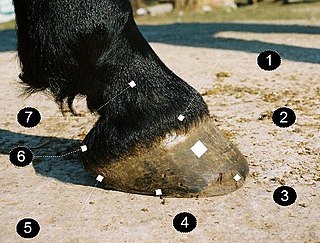
A horse hoof is the lower extremity of each leg of a horse, the part that makes contact with the ground and carries the weight of the animal. It is both hard and flexible. It is a complex structure surrounding the distal phalanx of the 3rd digit of each of the four limbs, which is covered by soft tissue and keratinised (cornified) matter.

In footwear, a hobnail is a short nail with a thick head used to increase the durability of boot soles or provide traction

Horse grooming is hygienic care given to a horse, or a process by which the horse's physical appearance is enhanced for horse shows or other types of competition.

Cleats or studs are protrusions on the sole of a shoe or on an external attachment to a shoe that provide additional traction on a soft or slippery surface. They can be conical or blade-like in shape and can be made of plastic, rubber or metal. The type worn depends on the environment of play: grass, ice, artificial turf, or other grounds.

A caulkin is a blunt projection on a horseshoe or oxshoe that is often forged, welded or brazed onto the shoe. The term may also refer to traction devices screwed into the bottom of a horseshoe, also commonly called shoe studs or screw-in calks. These are usually a blunt spiked cleat, usually placed at the sides of the shoe.

Natural hoof care is the practice of keeping horses so that their hooves are worn down naturally, or trimmed to emulate natural wear, so they do not suffer overgrowth, splitting and other disorders. Horseshoes are not used, but domesticated horses may still require trimming, exercise and other measures to maintain a natural shape and degree of wear.

The Horse Protection Act of 1970 (HPA); is a United States federal law, under which the practice of soring is a crime punishable by both civil and criminal penalties, including fines and jail time. It is illegal to show a horse, enter it at a horse show, or to auction, sell, offer for sale, or transport a horse for any of these purposes if it has been sored.
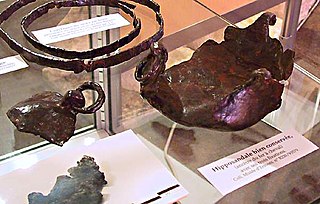
The hipposandal is a device that protected the hoof of a horse. It was commonplace in the northwestern countries of the Roman Empire, and was a predecessor to the horseshoe.
Soring, or "big lick", is defined as the application of any chemical, mechanical agent, or practice inflicted upon any limb of a horse, that can cause or be expected to cause the horse to suffer physical pain or distress when moving. This results in the horses picking up their front feet higher and faster than they would do in their natural gait. Trainers use soring to give a horse a highly animated gait in a short time period rather than spending time training them to perform this gait naturally. People who sore their horses believe that it gives them a competitive edge over other horses in the show ring. However, soring is illegal in the United States under the Horse Protection Act of 1970. Tennessee Walking Horses are not allowed to be shown without passing a USDA and HPA inspection for soring and physical inspection; they are not allowed to have scars on their pastern as it is associated with soring. Other breeds that have a history of soring including the Racking Horse and the Spotted Saddle Horse.


